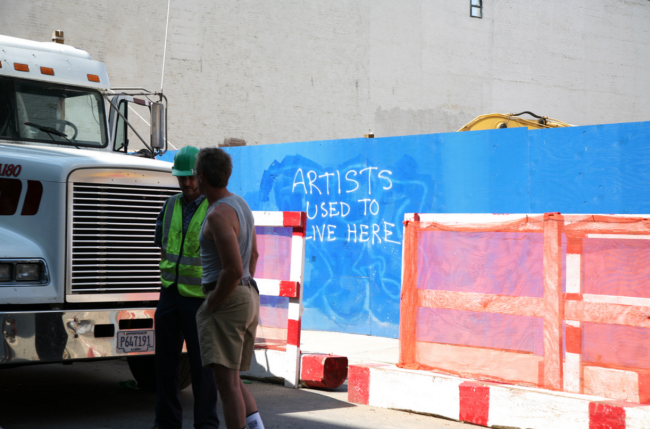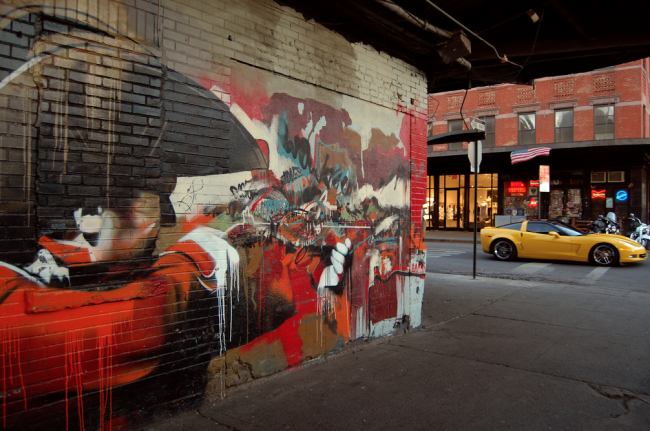A new exhibit explores the complicated relationship between artists and gentrification

The arrival of artists to a neighborhood is frequently seen as an early warning sign of gentrification.
When young artists move into an area in search of affordable housing, their arrival is often seen as a harbinger of gentrification and displacement to come. The phenomenon is common enough that it has been dubbed The Soho Effect, based on the downtown neighborhood’s rapid transformation after creative types started snapping up loft space in the 1970s. Developers have discovered the galvanizing effect that artists can have on “under-the-radar” corners of the city, and according to an article in Quartz, some are flipping the script and attempting to draw youthful trendsetting types to places where they want to build, rather than following them there.
All this is to say that the relationship between art and real estate can become a contentious one. And fodder for creative work. CityLab reports that New York artists William Powhida and Jennifer Dalton are planning a month-long, interactive project called “Month2Month” that delves into this complicated overlap. Like luxury real estate, the fine and performing arts are often perceived as out of reach for the poor—consider the cost of tickets to see Hamilton, the New York Philharmonic, or a special exhibit at MoMA—and “Month2Month” aims to throw open the doors to both high-end homes and art to all.
The exhibit centers on free, four-night residencies in Gramercy Park, the East Village, and the Lower East Side, available to applicants by lottery; each is set in a unit deemed either “luxury” or “affordable.” The apartments double as the settings for a series of public events exploring socioeconomic inequality in New York, as well as corresponding questions around gentrification and displacement. By opening otherwise private spaces—and by making each event free—Powhida and Dalton strive to remove barriers to the often-rarefied realms of real estate and art.
The calendar for “Month2Month” includes an artist-led, interactive activity in which participants are asked to envision a more equal New York; an evening called “Gentrifiers Anonymous,” in which those who feel guilty of catalyzing major changes to neighborhoods own up to their sins; an improv comedy set based on NYC apartments in pop culture; and more.
It’s an intriguing way of reckoning with the bind young writers, artists, and actors may find themselves in. They’re accused of blithely disregarding deeply entrenched local culture, but also find themselves priced out of the same neighborhoods that they’ve altered. Recently, a Bushwick artist placed a crochet mural on the side of a building without asking the owner’s permission, an act some saw as emblematic of “a much greater social epidemic,” according to Gothamist; at the same time, the Real Deal reports that many Bushwick artists are exiting that corner of Brooklyn as rents rise and developers try to entice wealthier tenants.
VICE recently interviewed Devin Kenny, an artist who led a panel discussion at MoMA PS1 about art and gentrification, and he pointed out that the intersection of the two is hardly black-and-white: “‘Artist’ isn't necessarily a class position," he says. "There are rich artists, poor artists, there are middle class artists, and there are art students who are also producers in a particular way within the economy." Asked what artists can do to avoid becoming gentrifiers, Kenny suggested “going into restaurants, talking to your neighbors, voting, going to community boards, all those kinds of things where you're actually viewing yourself as part of the neighborhood and larger ecosystem. And listening.”
Listening, along with discussing, is a major component of “Month2Month”; one of its events, “A Dinner with Doormen,” invites the often-overlooked guardians of the city’s residences to share what they have learned on the job about inequality. (Brick Underground has its own version of this—the series "Door to Door," in which Gabriel Falcon interviews doormen and women.) And the final event, “Where Are They Now?” seeks to locate a voice for those least heard during debates about a rapidly changing NYC: the New Yorkers who already gone, having been displaced from the city.
You Might Also Like




























